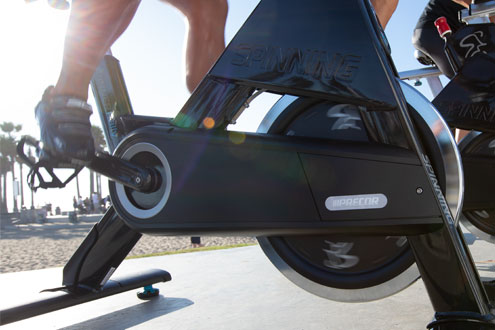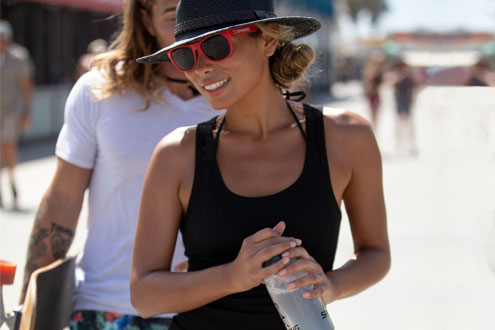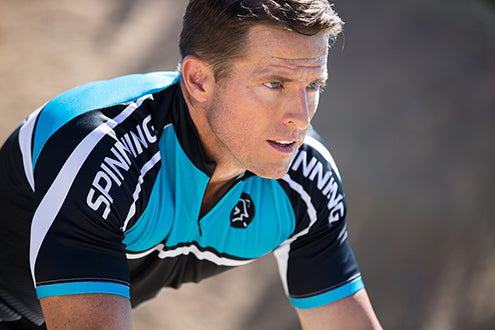Wendy Moltrup, MS, CHES
Wearing cycling-specific shoes for Spinning® class promotes efficient movement throughout the whole pedal stroke — it allows you to use the quadriceps and hamstrings effectively throughout the pedal stroke and to properly recruit the secondary muscle groups like the calves and shin muscles.
There is greater efficiency in the transfer of power and a more balanced use of the leg muscles, providing stability to the knee and reducing foot movement. You can also reduce foot discomfort because your cycling shoes are attached to the pedal, which can prevent numbness caused by athletic shoes squeezed into the narrow toe cages. Moreover, cycling shoes’ stiff soles can improve stability and reduce strain to the Achilles tendon and calf muscles.
What’s Different About The Design Of Cycling Shoes for Spinning® Class?
On the bottom of a cycling shoe, you’ll see two or three holes (Giro® offers a universal mount with both configurations), where you attach a cleat. The cleat attaches to the pedal. This shoe-cleat-pedal combination is referred to as a clipless pedal system.
Cycling shoes have hard, stiff soles, a retaining system, such as Velcro® straps so the shoe can fit snugly around your arch, and cleats that hold your feet securely in place on the pedals.
Note: Cycling shoes and cleats are usually sold separately so that the correct cleat can be selected to fit the bike’s pedal system.
Cycling Shoes for Spinning® Classes? | What Kind Should I Wear?
There are two basic types of clipless pedal systems:
- A recessed cleat or SPD® (Shimano Pedal Design) system, a two-hole cleat system;
- A non-recessed, three-hole cleat system used most often with road cycling shoes and pedals.
Most gyms have pedals on their Spinner® bikes that are compatible with the SPD system. The compatible cycling shoes will have a recessed cleat and rubberized soles. It’s easier and safer to walk in this type of cycling shoe.
Non-recessed cleats, such as LOOK® Delta cleats, have protruding cleats that can make walking difficult in a gym environment.
Your gym or studio may have pedals that work with either system and regular athletic shoes, so it’s best to always ask before you buy.
How Should My Shoes Fit?
Your cycling shoes should be comfortable from the beginning and may be a half to full size larger or smaller than your regular shoe size. There should be enough room in the front of the shoes to wiggle your toes.
When you get ready to ride, adjust the retaining system to fit snuggly around the arch of your foot. If your feet are falling asleep while you ride, you may have adjusted them a little too tightly. Try loosening the retaining system.
What About Socks?
Socks can be the key to comfort! To help keep your feet cool and minimize friction, which may cause blisters, your socks should be made of moisture-wicking fabric with reinforced heels and toes. Cycling-specific socks are also lightweight for a streamlined effect you’ll find in most cycling garments — and they look good too.
Remember, Before You Buy Cycling Shoes for your Spinning Class
- If you are buying shoes from a bike shop, ask if they include the cleats and if they will install them for you at no charge.
- Ask the gym or studio where you take Spinning® classes which pedal system they use on their Spinner® bikes.
- Talk to your Certified Spinning Instructor about recommendations and how to use the shoes while riding on your Spinner® bike.
You’ll find a variety of cycling shoes on Spinning.com. Review the size guide to help you find the best fit.
It’s easy to get the hang of clipless pedals and you’ll feel the difference with every pedal stroke and every ride!
Clip in and love your ride!

This cycling shoe sizing guide provides you with equivalent US and European sizing. Remember, your cycling shoe may be a half to a full size larger or smaller than your regular shoe size — focus on the fit, it should be comfortable with enough room to wiggle your toes.





Leave a comment
This site is protected by hCaptcha and the hCaptcha Privacy Policy and Terms of Service apply.